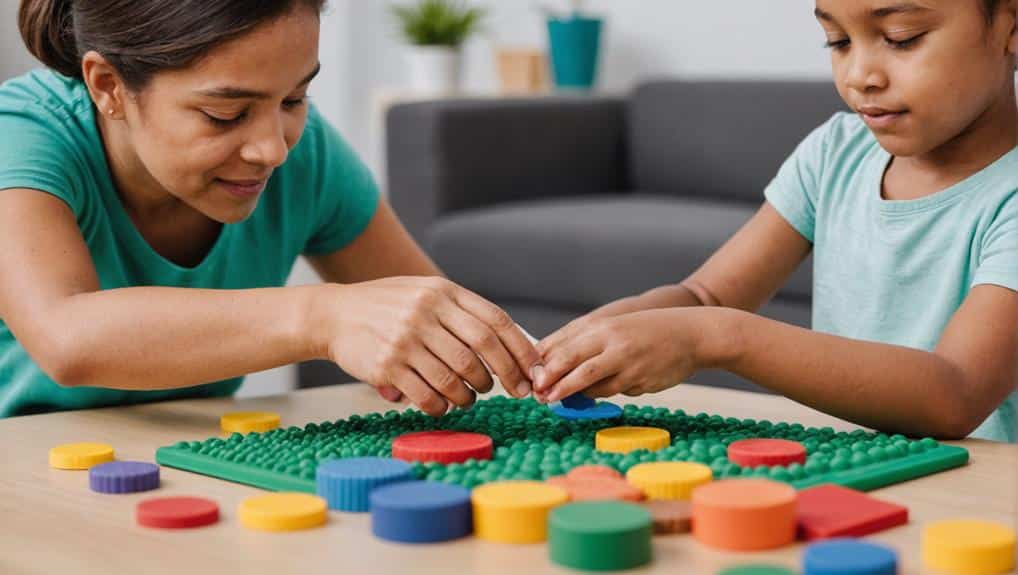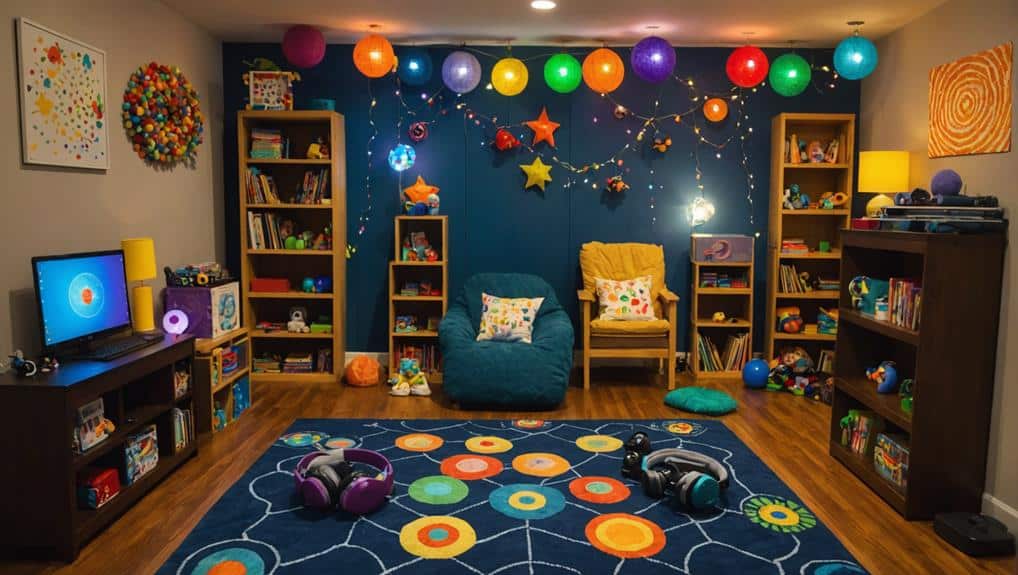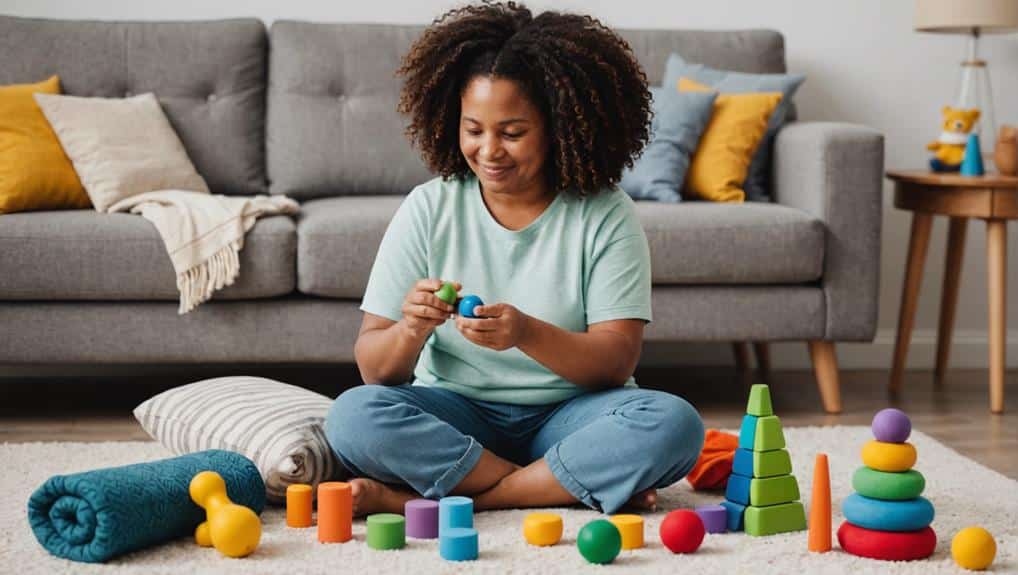Sensory Processing Disorders (SPD) can create unique challenges for children and their families, making everyday tasks feel overwhelming. For parents, understanding these disorders and recognizing their signs is the first step toward helping their child. It’s important to remember that you’re not alone in this journey. Many families face similar challenges and work together with professionals to overcome sensory disorders effectively.
Once you identify the signs of SPD, you can explore various strategies to support your child. From seeking a proper diagnosis to starting therapy, every step brings you closer to helping your child thrive. Therapy can include sensory integration techniques, occupational therapy, and even simple changes at home. You’ll learn how to create a sensory-friendly environment that meets your child’s unique needs and encourages them to grow in confidence and ability.
With patience and persistence, you can help your child overcome sensory disorders and navigate their world more comfortably. This guide will explore practical solutions, empower you with knowledge, and inspire you to take meaningful action. Together, we’ll answer important questions, like how to support your child’s progress and actively participate in their therapy journey. Let’s take this step toward a brighter, more sensory-friendly future for your family.
Key Takeaways
- Understand the signs and symptoms of SPD, as early diagnosis and intervention can lead to better outcomes.
- Seek help from occupational therapists who can provide sensory integration therapy and develop personalized treatment plans.
- Implement a sensory diet and create a sensory-friendly home environment to support your child’s sensory needs.
- Maintain consistent routines, use visual schedules, and offer sensory breaks to help manage daily activities and transitions.
- Participate in parent training programs and support groups to gain knowledge, share experiences, and receive practical strategies for managing SPD.
Understanding Sensory Processing Disorder
Diving headfirst into the intricate world of Sensory Processing Disorder (SPD), it’s fundamental to understand that this condition profoundly impacts how the brain interprets sensory information. SPD affects different senses, like sight, hearing, touch, taste, and smell, creating disruptions in everyday activities and social interactions. This often requires advocacy and community building to promote understanding and inclusivity, particularly in environments such as schools or workplaces.
Individuals with SPD may experience oversensitivity or undersensitivity to sensory stimuli. Such variations in sensory responses pose distinct challenges that require tailored care and attention. Occupational therapists play a pivotal role in diagnosing and managing SPD. They conduct evaluations through interviews, observations, and standardized assessments to understand the individual’s sensory experiences and challenges.
Treatment for SPD is multifaceted, encompassing occupational therapy, sensory integration therapy, environmental modifications, and personalized behavioral therapy. Each approach is customized to meet specific needs, aiming to improve sensory processing capabilities and enrich overall quality of life.
Lastly, support systems and resources are indispensable in managing SPD effectively. Support groups, educational materials, advocacy organizations, and parent training programs provide the necessary assistance to individuals and families. Understanding SPD is the initial step in creating an empathetic, inclusive environment for those living with this condition.
Recognizing Signs and Symptoms
In this section, we will highlight how to recognize signs and symptoms of Sensory Processing Disorder in your child. It’s crucial to note that sensory issues, like bright lights or loud noises, can also make specific social interactions, such as eye contact, challenging for those on the spectrum. We aim to guide you in identifying possible sensory overreactions and provide an understanding of typical behaviors associated with SPD. This knowledge, including understanding the complexities of eye contact for some people, is vital in seeking early intervention and support for your child.
Identifying SPD Symptoms
Understanding the symptoms of Sensory Processing Disorder (SPD) is a fundamental step for parents who may be concerned about their children’s behavior. In the pastAutismsm, which can involve sensory processing challenges, was frequently underdiagnosed due to a lack of comprehension and assistance UnderstandinAutismsm. SPD symptoms can appear in diverse ways, like reacting excessively or insufficiently to sensory stimuli. This might entail a child becoming highly agitated by the noise of a vacuum cleaner or, on the other hand, appearing unaffected by pain or extreme temperatures.
Children with SPD may also display sensory-seeking behaviors, such as a continual urge to touch objects or to twirl and leap around. Difficulties with changes in routine and adjustments, along with challenges in fine or gross motor skills, can indicate SPD. For example, a child might encounter problems with tasks like fastening their shirt or struggle with equilibrium and coordination.
Another significant symptom is the aversion to specific textures, sounds, or lights. This may be evident in a child who consistently rejects wearing certain kinds of clothing or who becomes excessively distressed by solid lights or loud noises. Recognizing these symptoms of sensory processing disorder is vital in seeking assistance and aiding your child effectively. Keep in mind that diagnosing SPD often entails standardized evaluations, sensory profiles, and cooperation among healthcare professionals.
Understanding Sensory Overreactions
Recognizing the signs and symptoms of sensory overreactions is an essential aspect of managing Sensory Processing Disorder (SPD). Sensory overreactions can manifest as extreme responses to sensory stimuli, often causing sensory overload in sensory kids. These overreactions can include heightened sensitivity to loud noises, bright lights, or certain textures, which can significantly impact daily living and social interactions.
Given the significance of early diagnosis, understanding these signs can pave the way for timely access to appropriate therapies, such as pediatric occupational therapy, which is crucial in managing SPD. Such responses can often lead to avoidance behaviors or meltdowns. For instance, a child might refuse to wear specific clothing due to discomfort from the fabric’s texture or may exhibit distress in a loud environment.
These are not tantrums but rather a neurological response to overwhelming sensory input. By understanding these signs, we can better support sensory kids. One essential strategy is to provide a calm and predictable environment to lessen the likelihood of sensory overload. Also, it’s necessary to keep in mind that each child is unique, and what may work for one may not necessarily work for another.
Diagnostic Process for SPD

Exploring the intricate world of Sensory Processing Disorder (SPD) can be overwhelming, but the diagnostic process is designed to provide clarity and precision. Conducted by trained occupational therapists, this detailed evaluation is pivotal to understanding and managing SPD. The diagnosis process encompasses several layers, from caregiver interviews to direct observations of the person, ensuring a thorough understanding of the situation.
Standardized assessments and sensory profiles are commonly used tools in the diagnostic process. These tools provide therapists with a structured method to identify and measure sensory processing issues, leading to more precise diagnoses. The table below gives an overview of the diagnostic process:
| Step | Tool | Purpose |
|---|---|---|
| 1 | Parent/Caregiver Interview | Gather background information |
| 2 | Direct Observation | Understand individual’s behaviors |
| 3 | Standardized Assessments & Sensory Profiles | Measure sensory processing capabilities |
Collaboration among healthcare professionals is essential during this process, ensuring an accurate diagnosis. Early detection and intervention play a crucial role in improving outcomes for individuals with SPD, so timely and correct diagnosis is paramount. This compassionate and thorough approach equips parents with knowledge and strategies to support their child’s distinct sensory needs.
Therapy Options and Treatments
After a thorough diagnosis of SPD, parents are often left wondering what the next steps are. The good news is there are several effective therapy options and treatments available to manage SPD effectively. Occupational therapy is a standard route designed to help individuals respond appropriately to sensory input. This form of therapy can make significant improvements in a child’s daily life.
Another therapeutic approach is sensory integration therapy. Conducted in a sensory gym, it employs tailored equipment like swings and weighted vests to provide sensory input in a structured, rhythmic way. This therapy can help children better process sensory information.
Environment modifications at home, such as creating a sensory-friendly space, can also be a part of the treatment plan. This can lessen sensory overload and promote a calming environment. Behavioral therapy may be used to address specific challenges related to sensory processing difficulties.
Role of Occupational Therapists

Occupational therapists play a pivotal role in the progression of a child with Sensory Processing Disorder (SPD). They employ a range of therapeutic techniques to help regulate the child’s responses to sensory stimuli. Their expertise extends beyond the therapy sessions, as they also equip parents with the knowledge and tools needed to support their child’s development at home. As we move forward, we will delve into these techniques and how parents can effectively participate in their child’s therapeutic process.
Therapeutic Techniques
While managing sensory processing issues can indeed be challenging, occupational therapists’ role in this process is crucial. These experts offer sensory integration therapy, a fundamental therapeutic method aimed at assisting individuals with sensory processing difficulties in navigating their sensory experiences more efficiently.
Occupational therapists evaluate each person’s particular sensory challenges and develop personalized treatment plans. They then advise families on how to apply these therapeutic methods at home, creating an atmosphere conducive to sensory regulation.
Occupational therapy uses specialized gear, often found in sensory gyms, to deliver precise sensory stimulation. Activities such as swinging, brushing, and weighted tasks have proven effective in addressing sensory obstacles and enhancing sensory processing.
Moreover, occupational therapists are not solitary fighters in this battle. They collaborate with other healthcare professionals, ensuring that the care provided is tailored and addresses all aspects of the condition. This level of assistance, along with the application of therapeutic methods, significantly boosts the individual’s capacity to handle their sensory processing issue.
Essentially, the path to conquering sensory processing problems involves a varied approach, with occupational therapists playing a vital role.
Parental Involvement
Exploring the complex world of Sensory Processing Disorder (SPD) is a shared expedition between therapists, parents, and the child. The role of parental engagement is crucial in this odyssey. Occupational therapists guide parents to continue therapy at home, creating a sensory diet tailored to the child’s distinct needs. It’s essential to ensure that the home environment supports the child’s sensory needs, much like preparing for holiday gatherings, which can aid individuals with autism.
This ongoing engagement provides consistency, a fundamental component of any effective treatment plan. The home becomes an extension of the therapy room, where the sensory diet can be practiced in a cozy and familiar environment. Parents can make subtle changes at home, such as crafting a sensory-friendly room or integrating sensory activities into their child’s daily routine. By upholding the routine, parents can assist their child in managing sensory challenges, akin to how individuals with autism can bring their routines to family interactions to maintain stability.
Parental engagement in SPD therapy is not simply advantageous—it is crucial. A cooperative approach ensures long-term success and a markedly enhanced quality of life for the child. Parents, armed with the proper knowledge and skills, become potent allies in managing SPD. Through their active engagement, they not only contribute to their child’s progress but also nurture a greater understanding of SPD within their community. Together, parents and therapists can make a tangible difference in the lives of children with SPD.
Parental Involvement in Therapy
Understanding the role of parents in sensory integration therapy is crucial. With a child diagnosed with Sensory Processing Disorder (SPD), parental involvement becomes a cornerstone for successful treatment. Trained by pediatric occupational therapists, parents become partners in therapy, extending the benefits of professional sessions into the home environment.
One of the key responsibilities of parents is creating a customized sensory diet for their child. This involves integrating recommended therapies and techniques into daily routines. This active participation ensures consistency in the treatment plan, which is essential in managing SPD.
Additionally, parents may need to make home modifications to support therapy. Creating sensory-friendly spaces or incorporating sensory tools can enrich the therapeutic environment. These adaptations can be as simple as adjusting lighting or as complex as setting up a sensory gym.
Understandably, this process can be demanding. However, the rewards are significant. Your child’s progress and improvement depend mainly on your commitment and perseverance. Remember, you are not alone in this process. Therapists, support groups, and numerous resources are available to guide you. Your involvement is not just beneficial—it’s life-changing—in your child’s path to overcoming SPD.
Sensory Integration and the Eight Senses

Sensory integration is a vital process that enables our brain to develop a thorough understanding of our surroundings by combining information from our eight senses. These senses go beyond the usual five – vision, scent, flavor, touch, and sound – to involve body awareness or proprioception, motion or vestibular sense, and interoception, our internal perception of physiological condition. As we delve into these senses more deeply, we will also talk about how sensory integration therapy can assist children with sensory processing disorders in managing sensory input, resulting in a more positive engagement with their environment.
Understanding Sensory Integration
Exploring sensory integration is like understanding a complex, finely-tuned orchestra. Each child, especially those with Sensory Processing Disorders (SPD), distinctly experiences the world and processes sensory information differently. Sensory integration therapy, a treatment often conducted by occupational therapists, acts as a conductor, harmonizing the discordant sensory inputs into a symphony of comfortable experiences.
Observing the child and consulting with caregivers is a crucial initial step in creating a personalized sensory diet. This unique plan of sensory activities helps promote appropriate responses to sensory stimuli, making the world less overwhelming for children with SPD. The environment for this therapy often resembles a sensory gym equipped with swings, weighted vests, and ball pits tailored to meet specific sensory needs.
Parents play a significant role in maintaining the continuity of therapy at home, establishing a consistent environment conducive to sensory integration. Regular evaluations not only help identify sensory needs but also track progress, providing a guide for navigating the intricate landscape of sensory integration. This insight is essential in assisting your child in overcoming SPD and experiencing the world in all its harmony.
The Eight Senses Defined
Building upon the foundation laid by sensory integration therapy, we move to a more detailed level in our discussion. To extensively address sensory processing disorder (SPD), we must understand the eight senses that form the core of our sensory experience.
| Sense | Description |
|---|---|
| Sight | Perception of light and color |
| Hearing | Perception of sound |
| Touch | Perception of pressure, temperature, and pain |
| Taste | Perception of flavors |
| Smell | Perception of odors |
| Proprioception | Body awareness: a sense of the body’s position in space |
| Vestibular | Sense of movement and balance |
| Interoception | Perception of the body’s internal state |
SPD can affect any or all of these senses. A person might have intense reactions to specific sensory inputs or, conversely, seek out more intense sensory experiences. This can lead to challenges in daily functioning and behavior. Through understanding and addressing these eight senses, parents and caregivers can better assist individuals with SPD, helping them to regulate and respond appropriately to sensory inputs. Knowledge of these eight senses equips us with the necessary tools to support those with SPD, promoting their well-being and enhancing their ability to interact with the world around them.
Techniques for Balancing Sensory Input
Exploring the complex world of sensory processing disorders can be a challenging task for parents. Understanding and effectively managing your child’s sensory input is a crucial step towards overcoming sensory issues. One technique that has been found to be particularly effective is sensory integration therapy.
Occupational therapists play an essential role in evaluating your child’s sensory defensiveness and cravings to create a tailored treatment plan. This therapy takes place in sensory gyms, which are specially designed-environments equipped with swings, weighted vests, and other sensory tools. These tools, combined with techniques like swinging, spinning, and brushing, offer a well-rounded sensory input that helps children regulate their responses to sensory stimuli.
Each child’s sensory needs are distinct, and so the therapy should not follow a one-size-fits-all approach. Instead, it should be customized, taking into account the child’s specific sensory issues. Remember, managing sensory input is not about eliminating sensory experiences but about finding the right balance that enables your child to function and thrive. As a parent or caregiver, your understanding, patience, and support in this process are invaluable.
Creating a Sensory-Friendly Environment

While sensory integration therapy plays a significant role in managing sensory processing disorders, the environment in which a child spends their time also has a notable impact. Creating a sensory-friendly climate is essential to minimizing sensory triggers such as loud noises and bright lights. Soft lighting, calming colors, and comfortable seating can transform an overwhelming space into a soothing sanctuary.
Another effective strategy is to utilize sensory tools. Items such as fidget toys, weighted blankets, and noise-canceling headphones can improve comfort and provide a sense of control over sensory experiences. These tools can be especially beneficial during times of high tension or stress.
Designating quiet areas in the home or classroom can also help in reducing sensory overload. These spaces provide a much-needed retreat when sensory inputs become too overwhelming.
The key to creating a sensory-friendly environment is customization. Understanding individual sensory needs and preferences can significantly improve well-being and reduce anxiety. Visual schedules, for instance, can be customized to each child’s needs, providing predictability and structure.
Managing Daily Routines and Transitions
Although daily routines and changes seem straightforward to most people, they can pose significant challenges for people with sensory processing disorders (SPD). The sensory issues associated with SPD can turn simple activities like getting dressed or brushing teeth into challenging tasks.
Adopting strategies such as visual schedules and sensory breaks can help ease adjustments, provide a sense of predictability, and reduce anxiety. Visual schedules use pictures to outline the sequence of daily activities, providing a guide that individuals with SPD can follow. Sensory breaks, on the other hand, are short periods of rest that allow the person to recharge and regain focus.
Consistency is crucial in managing SPD, as regular routines and clear expectations can reduce the occurrence of meltdowns. Understanding sensory triggers can also aid in managing daily schedules. By identifying these triggers, parents and caregivers can create sensory-friendly environments that make daily routines more manageable for individuals with SPD.
Advocacy and Support for Children With SPD

Given the complexities associated with Sensory Processing Disorder (SPD), advocacy and support play a vital role in enhancing the lives of affected children. Advocacy organizations work tirelessly to raise awareness, promote research, and push for policy changes that benefit children with sensory processing disorders. Their efforts aim to bring about a more inclusive society that understands and accommodates the distinct needs of these children.
Parent training programs are another essential cornerstone of support. By offering practical strategies for managing SPD at home, these programs equip parents with the necessary tools to provide their children with the support and advocacy they require. These strategies can significantly improve the quality of life for children with SPD.
Educational resources also help parents and caregivers better understand SPD, enabling them to offer more effective support. Furthermore, support groups provide a sense of community and understanding, fostering mutual encouragement among families facing similar challenges.
Frequently Asked Questions
What Is the Best Treatment for Sensory Processing Disorder?
The most effective treatment for sensory processing disorder involves a multidimensional approach, combining sensory integration therapy, environmental modifications, behavioral therapy, and occupational therapy, which is tailored to address the person’s distinct needs.
How to Parent a Sensory Processing Disorder Child?
How can parents best support a child with Sensory Processing Disorder? By understanding their distinct sensory needs, creating an accommodating environment, and implementing therapeutic strategies, parents can improve their children’s ability to navigate their sensory experiences successfully.
What Are the Four Types of Sensory Processing Disorder?
The four types of Sensory Processing Disorders are Sensory Modulation Disorder, Sensory-Based Motor Disorder, Sensory Discrimination Disorder, and another subtype of Sensory-Based Motor Disorder. Each affects sensory responses, motor skills, interpretation, and execution.
How to Help a Child With SPD at Home?
To help a child with SPD at home, implement a sensory diet, create a sensory-friendly environment, encourage physical activities, and establish routines. Consult with an occupational therapist for customized strategies tailored to your child’s needs.
Conclusion
Navigating the challenges of Sensory Processing Disorder may feel overwhelming at first, but it’s a journey you don’t have to face alone. By focusing on early identification, creating a sensory-friendly environment, and staying actively engaged in your child’s progress, you can help them overcome sensory disorders and thrive. With support from your community and collaboration with experienced professionals, you’ll find the tools and guidance needed to make meaningful progress.
If you have questions or need additional help, don’t hesitate to reach out to a pediatric therapy center. These experts can provide personalized strategies and support tailored to your child’s unique needs. Remember, every step you take brings you closer to helping your child overcome sensory disorders and reach their full potential. You’re not alone on this path—help is always available.


Recent Comments